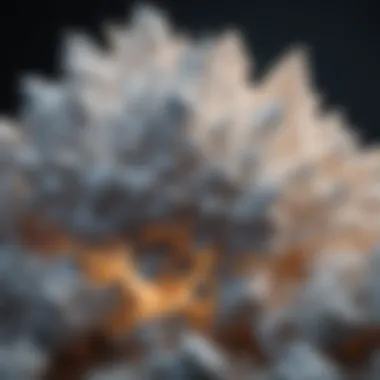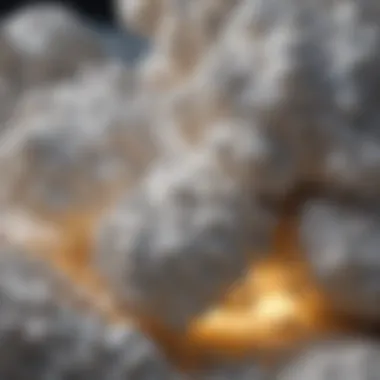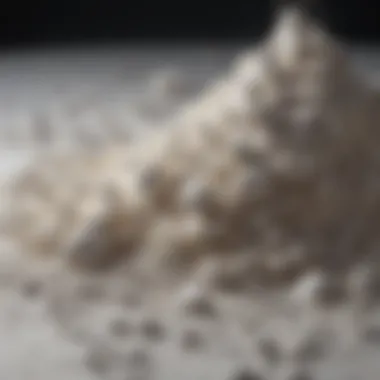Unveiling the Composition of Talc: A Geological Exploration


Rock and Fossil Identification
In the realm of geological exploration, understanding the identification of rocks and fossils is fundamental. Geologists and enthusiasts alike must grasp the various types of rocks and fossils, ranging from sedimentary to metamorphic, each with unique characteristics that offer clues about their formation and history. Aspiring collectors should look for specific attributes, such as color, texture, and mineral composition, to differentiate between different rock types and discern the presence of fossils within them. Utilizing tools like geology hammers, chisels, and magnifying glasses is crucial in the detailed examination and identification of rocks and fossils.
Geological Insights
When delving into the composition of talc, a valuable geological insight emerges, revealing the intricate processes that create this mineral. Through studying the geological formations where talc is found, one can uncover the significance of specific mineralogical compositions and their role in the earth's history. The historical relevance of talc extends back through time, with notable discoveries shedding light on its uses and importance in various industries. Exploring the geological context of talc provides a deeper understanding of how these minerals are formed, shaped by geological forces, and unearthed by dedicated researchers and collectors seeking to uncover the mysteries of the earth.
Introduction
In this article, we embark on a profound journey into unraveling the intricate composition of talc, a mineral that holds immense geological significance. By delving deep into the mineralogical properties of talc, we aim to shed light on its formation and key characteristics that make it a compelling subject of study within the realms of geology.
Exploring the World of Talc
The Origins of Talc
The origins of talc trace back to geological processes that have shaped its unique properties over time. From its formation deep within the Earth's crust to its various transformations, understanding the origins of talc provides valuable insights into its composition and formation. The geological history behind talc's origins unveils a fascinating narrative of environmental conditions and mineral interactions that have culminated in the mineral we recognize today. Exploring the origins of talc offers a glimpse into the intricate processes that give rise to this mineral and underscores the importance of studying its geological roots.
Talc in Geological Context
Placing talc within its geological context allows us to appreciate its role in Earth's history and current geological phenomena. Talc's presence in specific rock formations and geological settings offers clues about past environments and mineral interactions. Understanding talc in its geological context provides a holistic view of its significance in earth sciences, highlighting its contribution to our comprehension of geological processes and mineral formations. By studying talc in relation to its geological surroundings, we gain a deeper appreciation for its unique properties and relevance in the field of geology.
Significance of Understanding Talc Composition
Industrial Applications


The industrial applications of talc stem from its distinctive chemical and physical properties that make it a valuable resource across various industries. From its use in cosmetics to its presence in ceramics, talc plays a vital role in enhancing product quality and performance. The diverse industrial applications of talc underscore its versatility and contribution to the manufacturing sector, where its unique characteristics cater to specific production needs. Exploring the industrial applications of talc allows us to recognize its economic importance and indispensable role in numerous industrial processes.
Geological Implications
Delving into the geological implications of understanding talc composition unveils its significance in deciphering past geological events and processes. By studying talc's chemical composition and occurrence patterns, geologists can glean insights into the Earth's evolution and mineral deposition mechanisms. The geological implications of talc extend beyond its physical properties, offering a window into ancient geological environments and tectonic activities. Understanding the geological implications of talc composition is crucial for interpreting geological data and unraveling the Earth's geological history.
Chemical Composition of Talc
Talc is renowned for its unique chemical composition that plays a pivotal role in various industrial and geological applications. Understanding the chemical makeup of talc is fundamental to unraveling its properties and significance within the context of mineralogy. By delving deep into the chemical structure of talc, we can decipher its molecular components and how they influence its behavior and interaction with its surroundings. This section sheds light on the specific elements present in talc, highlighting their benefits and considerations within the realm of talc composition.
Silicate Structure of Talc
Talc's Molecular Composition
Talc's molecular composition is characterized by the presence of magnesium, silicon, and oxygen atoms arranged in distinct layers, creating a unique silicate structure. This arrangement grants talc its lamellar nature, contributing to its properties such as softness and greasiness. The high magnesium content in talc imparts its characteristic smoothness, making it a popular choice in various cosmetic and industrial applications. Understanding talc's molecular composition is essential in grasping its behavior in geological settings and its diversified usage across different industries.
Crystallographic Properties
Talc exhibits exceptional crystallographic properties due to its hexagonal structure and perfect basal cleavage. This specific arrangement allows talc to showcase unique optical properties and planar surfaces, making it an ideal mineral for studying crystallography and mineral identification. The crystallographic nature of talc influences its physical characteristics, such as hardness and color, which are integral factors in differentiating talc varieties and determining their suitability for specific applications. By exploring talc's crystallographic properties, we can uncover valuable insights into its geological significance and industrial utility.
Trace Elements in Talc
Impurities and Their Effects
The presence of trace elements and impurities in talc can significantly impact its properties and applications. Understanding the effects of impurities on talc is crucial for ensuring its desired quality and performance in various industries. Impurities can alter talc's color, texture, and chemical reactivity, affecting its usability in different products and processes. This subsection delves into the nuances of impurities in talc and their diverse effects, emphasizing the importance of quality control and purity assessment in talc mining and processing.


Geological Analysis of Trace Metals
Geological analysis of trace metals in talc provides valuable insights into its formation and depositional history. By studying the trace metal composition of talc deposits, geologists can infer geological processes, environmental conditions, and ore genesis mechanisms. These analyses help in reconstructing the evolutionary pathways of talc deposits, elucidating the natural factors that influenced their formation and evolution over time. This section delves into the significance of geological analysis of trace metals in unraveling the geological context of talc occurrences and understanding their intrinsic value in earth sciences and economic geology.
Physical Characteristics of Talc
Talc's physical characteristics play a crucial role in understanding its composition and geological significance within the context of this article. By delving into the texture and appearance of talc, readers can grasp the unique attributes that make this mineral distinct. The analysis of physical characteristics offers valuable insights into talc's formation, structure, and properties, shedding light on its uses and implications in various fields.
Texture and Appearance
Exploring the texture and appearance of talc unveils essential details about its visual and tactile qualities. Color variations in talc provide valuable information regarding mineral impurities, alterations due to environmental factors, and the geological processes involved in its formation. Understanding color variations aids in identifying different talc deposits and assessing their mineralogical compositions, offering valuable data for geological studies and industrial applications.
Color Variations in Talc
Color variations in talc signify diverse mineral compositions and impurities present in different geological environments. The hues observed in talc, ranging from white to gray and even green, reflect the influences of varying elements like iron oxides, chlorites, or organic matter. These colors not only enhance the aesthetic appeal of talc but also serve as indicators of geological conditions during talc formation, aiding researchers in determining the mineral's origin and properties. Exploring the color variations in talc unveils the intricate interplay of natural processes that influence its appearance, providing valuable insights into the mineral's geological history and potential applications.
Cleavage and Fracture Patterns
Analyzing the cleavage and fracture patterns of talc enables a deeper understanding of its structure and mechanical properties. The distinct cleavage of talc into thin, platy sheets showcases its perfect basal cleavage, allowing for easy separation along parallel planes. This unique characteristic contributes to talc's applications in various industries, such as cosmetics and ceramics, where the mineral's sheet-like structure is advantageous. Fracture patterns in talc exhibit its response to external forces, showcasing its resilience and brittleness under different conditions. By studying cleavage and fracture patterns, researchers can gain insights into talc's physical behavior, aiding in mineral identification, classification, and utilization in industrial processes.
Hardness and Mohs Scale
Talc's hardness and ranking on the Mohs scale are pivotal aspects that define its physical properties and practical applications. Understanding talc's position on the Mohs scale elucidates its relative hardness compared to other minerals, highlighting its softness and ease of scratching. This knowledge informs geologists and material scientists about talc's abrasive qualities and its suitability for specific industrial uses. Practical applications of hardness in talc encompass its use as a lubricant, filler material, or absorbent due to its softness and smooth texture. Talc's hardness characteristics influence its performance in cosmetic products, pharmaceutical formulations, and industrial processes, making it a versatile mineral with diverse applications.
Geological Formation of Talc


The significance of the topic 'Geological Formation of Talc' in this article lies in unraveling the intricate processes that contribute to the creation of talc deposits. By delving into the geological formation of talc, we can uncover essential insights into the origins and characteristics of this mineral. Understanding the geological processes that lead to the formation of talc is crucial for interpreting its properties and identifying potential deposits for exploration. The geological formation of talc involves a series of complex metamorphic processes and depositional environments that shape its composition and distribution on Earth.
Metamorphic Processes
Protolith Transformations
Protolith transformations play a pivotal role in the overall geological formation of talc, as they represent the precursor rocks that undergo metamorphic changes to give rise to talc-bearing formations. The key characteristic of protolith transformations lies in their ability to undergo mineralogical and structural alterations under specific geological conditions, eventually leading to the formation of talc-rich rocks. This aspect is beneficial for this article as it sheds light on the evolutionary path of talc formation, highlighting the stages of metamorphic evolution that culminate in the creation of talc deposits. The unique feature of protolith transformations is their role in preserving the geological history and environment in which talc-bearing rocks originated, providing valuable insights into the Earth's dynamic processes.
Temperature and Pressure Effects
Temperature and pressure effects constitute essential factors influencing the metamorphic processes responsible for talc formation. These two parameters control the conditions under which talc crystallizes and transforms within the Earth's crust, shaping its physical and chemical characteristics. The key characteristic of temperature and pressure effects is their impact on the stability and polymorphism of talc minerals, dictating their occurrence in specific geological settings. This aspect is beneficial for this article as it elucidates the role of thermodynamic conditions in talc formation, highlighting how variations in temperature and pressure influence the metamorphic evolution of talc-bearing rocks. The unique feature of temperature and pressure effects lies in their ability to exert control over the crystallization and transformation of talc minerals, ultimately determining the mineral assemblages found in talc deposits.
Occurrence and Deposition
Geological Settings of Talc Deposits
The geological settings of talc deposits provide crucial insights into the environments where talc accumulates and the tectonic processes responsible for its concentration. Understanding the specific geological settings that favor talc deposition is essential for predicting the distribution of talc-bearing rocks and identifying potential reserves for resource exploitation. The key characteristic of geological settings of talc deposits lies in their association with particular rock types and structural boundaries that influence talc accumulation. This aspect is beneficial for this article as it clarifies the geological factors controlling the formation of talc-rich deposits, shedding light on the spatial relationships and geological contexts favorable for talc mineralization. The unique feature of geological settings of talc deposits is their role in guiding exploration strategies and resource assessments, helping to delineate areas of economic interest for talc extraction.
Hydrothermal and Metasomatic Origins
The hydrothermal and metasomatic origins of talc underscore the significance of fluid-mediated processes in talc mineralization within diverse geological settings. These processes involve the infiltration of hydrothermal fluids or the exchange of chemical elements between rocks, leading to the formation of talc deposits through alteration reactions. The key characteristic of hydrothermal and metasomatic origins is their role in enriching talc concentrations in specific rock units through mineral replacement and precipitation mechanisms. This aspect is beneficial for this article as it elucidates the mechanisms of talc formation in hydrothermal and metasomatic environments, highlighting the reactive pathways that give rise to talc-rich occurrences. The unique feature of hydrothermal and metasomatic origins lies in their ability to generate localized concentrations of talc through fluid-induced alterations, contributing to the formation of economically viable talc deposits.
Conclusion
Insights into Talc's Essence
Summarizing Key Findings
The section 'Summarizing Key Findings' serves as a pivotal component of this article, encapsulating the essence of talc's composition and geological implications. By synthesizing the research findings, we have identified key characteristics that define talc's molecular structure and crystallographic properties. This summary not only provides a concise overview of talc's composition but also highlights the practical significance of these findings in various industrial and geological settings. The detailed analysis of talc's chemical composition and trace elements offers a unique perspective on the mineral's properties, setting the stage for further exploration and understanding of talc's significance.
Implications for Future Research
The 'Implications for Future Research' section extends the discourse on talc's composition, paving the way for future studies and investigations. By outlining potential research avenues and applications, this section underscores the ongoing relevance of talc in geological studies and industrial applications. The identification of trace metals and impurities in talc opens new possibilities for in-depth geological analysis and exploration. Furthermore, the implications of future research on talc's formation and characteristics provide a roadmap for expanding our understanding of this mineral, driving innovation and progress in the field of mineralogy and geology.







